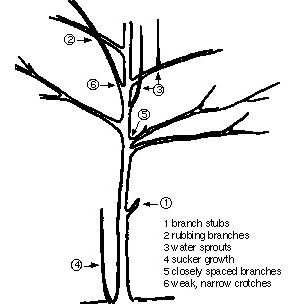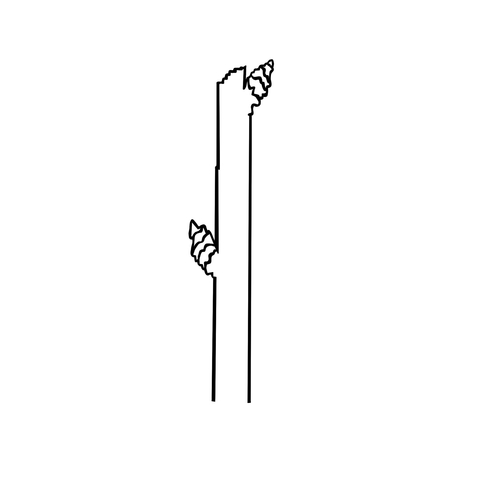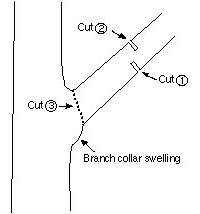Quick facts
- Pruning changes the form and growth of a plant.
- Pruning can also be considered preventive maintenance for both insect and disease damage.
- Many problems may be prevented by pruning correctly during the formative years for a tree or shrub.
- The late dormant season is the best time for most pruning.
Prune to promote plant health
- Remove dead or dying branches injured by disease, severe insect infestation, animals, storms, or other adverse mechanical damage.
- Remove branches that rub together.
- Remove branch stubs
Avoid topping trees. Removing large branches leaves stubs that can cause several health problems. It also destroys the plant's natural shape and promotes suckering and the development of weak branch structures.
Prune to maintain intended purposes for plants in a landscape
- To encourage flower and fruit development.
- To maintain a dense hedge.
- To maintain or encourage a desired plant form or special garden forms.
Prune to improve plant appearance
Appearance in the landscape is essential to a plant's usefulness. For most landscapes, a plant's natural form is best.
Avoid shearing shrubs into tight geometrical forms unless they need to be confined or trained for a specific purpose. When plants are properly pruned, it's hard to tell that they've been pruned.
Pruning:
- Controls plant size and shape.
- Keeps shrubby evergreens well-proportioned and dense.
- Removes unwanted branches, waterspouts, suckers and undesirable fruiting structures that detract from plant appearance.
Prune to protect people and property
- Remove dead branches.
- Have hazardous trees taken down.
- Prune out weak or narrow-angled tree branches that overhang homes, parking areas, sidewalks and anyplace falling limbs could injure people or damage property.
- Eliminate branches that interfere with street lights, traffic signals and overhead wires.
- DO NOT attempt to prune near electrical and utility wires. Contact utility companies or city maintenance workers to handle it.
- Prune branches that block vision at intersections.
- For security purposes, prune shrubs or tree branches that obscure the entry to your home.
Use the right tools for pruning
The right tools make pruning easier and help you do a good job. Keeping tools well-maintained and sharp will improve their performance. There are many tools for pruning, but the following will probably suffice for most applications:
- A good pair of pruning shears is probably one of the most important tools. Cuts up to 3/4 inches in diameter may be made with them.
- Lopping shears are similar to pruning shears, but their long handles provide greater leverage needed to cut branches up to 1 1/2 inches in diameter.
- Hedge shears are meant only for pruning hedges, nothing else. They usually cut succulent or small stems best.
- Hand saws are very important for cutting branches over 1 inch in diameter. Many types of hand saws are available. Special tri-cut or razor tooth pruning saws cut through larger branches – up to 4 inches in diameter – with ease.
- Pole saws allow for extended reach with a long handle, but they must be used carefully as it is difficult to achieve clean cuts with them.
- Small chain saws are available for use on larger branches. Operators must wear protective clothing and exercise caution when using them. Never use chain saws to reach above your shoulders, or when you are on a ladder.
How to prune trees and shrubs
- Remove diseased, broken or dead branches.
- Remove any downward-growing branches.
- If two limbs are crossed, entangled or otherwise competing, remove one of them completely at its base.
- Remove any limbs along the trunk that are bigger in diameter than the trunk.
- Remove suckers coming up from the roots or low on the trunk.
- Remove vigorous vertical branches, called watersprouts.
- Make pruning cuts close to the branch collar at the base of the limb.
- For larger limbs, start the cut from the underside of the limb to avoid tearing the bark.
- Remove large limbs first, starting with the top of the tree.
- "Thinning" cuts remove entire branches at the branch collar and are usually the recommended type of cut.
- "Heading" cuts remove only part of a branch and encourage vegetation growth below the cut and are not as common.
Pruning begins at planting time
Pruning is really the best preventive maintenance for young plants. It is critical for young trees to be trained to encourage them to develop a strong structure.
Young trees pruned improperly or not pruned at all for several years may require heavy pruning to remove bigger branches to prevent trees from becoming deformed.
At planting, remove only diseased, dead or broken branches. Begin training a plant during the dormant season following planting.
- Prune to shape young trees, but don't cut back the leader.
- Remove crossing branches and branches that grow back towards the center of the tree.
- As young trees grow, remove lower branches gradually to raise the crown, and remove branches that are too closely spaced on the trunk.
- Remove multiple leaders on evergreens and other trees where a single leader is desirable.
Shrubs
Pruning young shrubs is not as critical as pruning young trees, but take care to use the same principles to encourage good branch structure. Container-grown shrubs require little pruning.
- When planting deciduous shrubs, thin out branches for good spacing and prune out any broken, diseased or crossing or circling roots.
- When planting deciduous shrubs for hedges, prune each plant to within 6 inches of the ground.
Leave the pruning of large trees to qualified tree care professionals who have the proper equipment. Consider the natural form of large trees whenever possible. Most hardwood trees have rounded crowns that lack a strong leader and may have many lateral branches.
The most common types of tree pruning are:
- Crown thinning – selectively removing branches on young trees throughout the crown. This promotes better form and health by increasing light penetration and air movement. Strong emphasis is on removing weak branches. (Don't overdo it on mature trees.)
- Crown raising – removing lower branches on developing or mature trees to allow more clearance above lawns, sidewalks, streets, etc.
- Crown reduction – removing larger branches at the top of the tree to reduce its height. When done properly, crown reduction pruning is different from topping because branches are removed immediately above lateral branches, leaving no stubs. Crown reduction is the least desirable pruning practice. It should be done only when absolutely necessary.
- Crown cleaning – the selective removal of dead, dying and diseased wood from the crown.
Proper branch pruning
- To shorten a branch or twig, cut it back to a side branch or make the cut about 1/4 inch above the bud.
- Always prune above a bud facing the outside of a plant to force the new branch to grow in that direction.
Pruning large branches
To remove large branches, three or four cuts will be necessary to avoid tearing the bark.
- Make the first cut on the underside of the branch about 18 inches from the trunk.
- Undercut one-third to one-half way through the branch.
- Make the second cut an inch further out on the branch; cut until the branch breaks free.
Use multiple cuts to remove large branches
Before making the final cut severing a branch from the main stem, identify the branch collar.
- The branch collar grows from the stem tissue around the base of the branch.
- Make pruning cuts so that only branch tissue (wood on the branch side of the collar) is removed.
- Be careful to prune just beyond the branch collar, but DON'T leave a stub.
- If the branch collar is left intact after pruning, the wound will seal more effectively and stem tissue probably will not decay.
The third cut may be made by cutting down through the branch, severing it. If, during removal, there is a possibility of tearing the bark on the branch underside, make an undercut first and then saw through the branch.
Wound dressing is not normally needed on pruning cuts. However, if wounds need to be covered to prevent insect transmission of certain diseases such as oak wilt, use latex rather than oil-based paint.
When to prune
The late dormant season (late winter to early spring) is best for most pruning.
Pruning in late winter, just before spring growth starts, leaves fresh wounds exposed for only a short length of time before new growth begins the wound sealing process. Another advantage of dormant pruning is that it's easier to make pruning decisions without leaves obscuring plant branch structure.
Pruning at the proper time can avoid certain disease and physiological problems:
- To avoid oak wilt disease DO NOT prune oaks from April to October.
- If oaks are wounded or must be pruned during these months, apply wound dressing or latex paint to mask the odor of freshly cut wood so the beetles that spread oak wilt will not be attracted to the trees.
- To avoid stem cankers, prune honeylocusts when they are still dormant in late winter.
- If they must be pruned in summer, avoid rainy or humid weather conditions.
- Prune apple trees, including flowering crabapples, mountain ash, hawthorns and shrub cotoneasters in late winter (February-early April).
- Spring or summer pruning increases the chances for infection and spread of the bacterial disease fireblight.
- Autumn or early winter pruning is more likely to result in drying and die-back at pruning sites.
- Some trees have free-flowing sap that "bleeds" after late winter or early spring pruning. Though this bleeding causes little harm, it may still be a source of concern.
- To prevent bleeding, prune the following trees after their leaves are fully expanded in late spring or early summer.
- Never remove more than 1/4 of the live foliage. Examples include:
- All maples, including box elder
- Butternut and walnut
- Birch and its relatives, ironwood and blue beech
Trees and shrubs that bloom early in the growing season on last year's growth should be pruned immediately after they finish blooming:
- Apricot
- Azalea
- Chokeberry
- Chokecherry
- Clove currant
- Flowering plum
- Flowering cherry
- Forsythia
- Juneberry
- Lilac
- Magnolia
- Early blooming spirea
Shrubs grown primarily for their foliage rather than showy flowers should be pruned in spring, before growth begins:
- Alpine currant
- Barberry
- Buffaloberry
- Burning bush
- Dogwood
- Honeysuckle
- Ninebark
- Peashrub
- Purpleleaf sandcherry
- Smokebush
- Sumac
Shrubs that bloom on new growth may be pruned in spring before growth begins.
- Plants with marginally hardy stems such as clematis and shrub roses should be pruned back to live wood.
- Hardier shrubs such as late blooming spireas and smooth (snowball) hydrangeas should be pruned to the first pair of buds above the ground.
Pruning hedges
- After the initial pruning at planting, hedges need to be pruned often.
- Once the hedge reaches the desired height, prune new growth back whenever it grows another 6 to 8 inches.
- Prune to within 2 inches of the last pruning.
- Hedges may be pruned twice a year, in spring and again in mid-summer, to keep them dense and attractive.
- Prune hedges so they're wider at the base than at the top, to allow all parts to receive sunlight and prevent legginess.
Renewal pruning for older or overgrown shrubs
- Every year remove up to one-third of the oldest, thickest stems or trunks, taking them right down to the ground. This will encourage the growth of new stems from the roots.
- Once there are no longer any thick, overgrown trunks left, switch to standard pruning as needed.
Rejuvenation pruning for older or overgrown shrubs
Deciduous shrubs that have multiple stems (cane-growth habit), and that have become very overgrown or neglected can be rejuvenated by cutting all canes back as close to the ground as possible in early spring.
That season's flowers may be sacrificed but the benefits from bringing the plants back to their normal size and shape outweigh this temporary collateral damage.
This pruning technique works best for shrubs such as overgrown spirea, forsythia, cane-growth viburnums, honeysuckle and any other multiple stemmed shrubs that are otherwise healthy. Within one growing season, these shrubs will look like new plantings, full and natural shaped.
With few exceptions, evergreens (conifers) require little pruning. Different types of evergreens should be pruned according to their varied growth habits.
- Spruces, firs and douglas-firs don't grow continuously, but can be pruned any time because they have lateral (side) buds that will sprout if the terminal (tip) buds are removed.
- It's probably best to prune them in late winter, before growth begins.
- Some spring pruning, however, is not harmful.
- Pines only put on a single flush of tip growth each spring and then stop growing.
- Prune before these new needles become mature.
- Pines do not have lateral buds, so removing terminal buds will take away new growing points for that branch. Eventually, this will leave dead stubs.
- Pines seldom need pruning, but if you want to promote more dense growth, remove up to two-thirds of the length of newly expanded candles.
- Don't prune further back than the current year's growth.
- Arborvitae, junipers, yews, and hemlocks grow continuously throughout the growing season.
- They can be pruned any time through the middle of summer.
- Even though these plants will tolerate heavy shearing, their natural form is usually most desirable, so prune only to correct growth defects.
Reviewed in 2022




